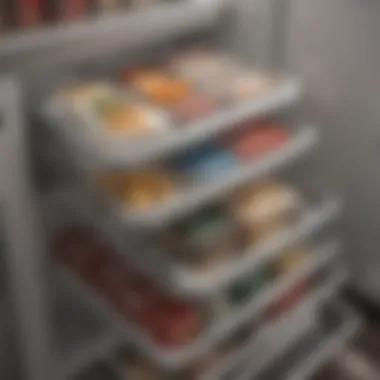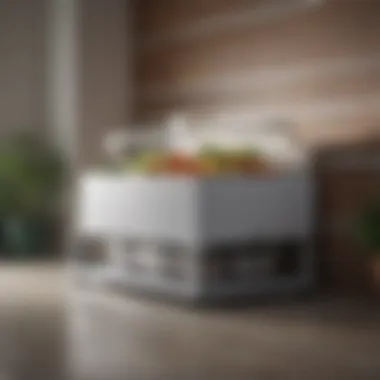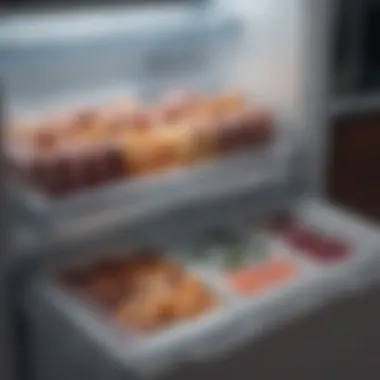Maximizing Chest Freezer Space: Smart Storage Ideas


Intro
Maintaining order in your chest freezer isn't just a matter of convenience; it's an investment in time and resources. The reality is, if you’ve ever dug around in a frozen abyss, squinting through icy layers to find the last bag of peas, you’ll know just how pivotal it is to have a system in place. This guide is tailored for anyone aiming to make the most out of their chest freezer, whether you’re stacking up on seasonal produce or prepped for meal-planning marathon weekends.
Optimizing storage solutions goes beyond simply shoving items in with reckless abandon. It invites an exploration of effective strategies to enhance space utilization, gain easy access to your frozen goods, and navigate the tricky waters of organization that many homeowners face. With proper planning and the right tools, your chest freezer can evolve from a daunting tundra into an organized sanctuary of preserved meals and ingredients.
Let’s embark on this journey to dissect proven tactics, clever storage ideas, and state-of-the-art containers that promise to elevate your freezer game to robust levels.
Prologue to Chest Freezers
Understanding Chest Freezers
To put it plainly, chest freezers are large, horizontal freezers that provide ample storage space compared to traditional upright models. They are typically characterized by a top-opening lid and have a higher energy efficiency rating due to their design. Being closer to the ground means that cold air doesn’t escape as easily when the freezer is opened, which is a nifty feature for maintaining temperature levels.
When one considers the purchase of a chest freezer, it’s vital to think about the layout of your home and lifestyle needs.
Benefits of Chest Freezers
The benefits of investing in a chest freezer are plentiful and shouldn’t be overlooked. Here are several key points that make them worth considering:
- Space Saving: Although they might take up more vertical space, their horizontal surface area allows for more efficient stacking of items.
- Energy Efficiency: Chest freezers generally use less energy than refrigerator freezers, saving you some coin in the long run.
- Long-Term Preservation: Foods stored in chest freezers can last much longer than those kept in conventional freezers, which is especially beneficial when stockpiling seasonal produce or meats.
- Flexible Storage: The expansive space allows for various food types and sizes, catering to different culinary needs, whether you're whipping up a weekend feast or securing future meals.
"A chest freezer can serve as a safety net, ensuring you’re always stocked up on essentials without frequent trips to the grocery store."
By optimal utilization of these unique features, homeowners can significantly increase their food storage capabilities, which is essential for busy lives. Understanding how to navigate the vast opportunities provided by chest freezers is just the first step in maximizing your kitchen's efficiency.
Assessing Your Storage Needs
When it comes to harnessing the full potential of your chest freezer, assessing your storage needs is absolutely crucial. Without a proper evaluation, even the best organization system can fall flat, leading to wasted space and lost items. Understanding what you have, and how you plan to use it, will help you tailor your storage solutions precisely to your requirements. This not only enhances efficiency but also saves time and reduces food wastage in the long run.
Evaluating Freezer Space
Start by measuring the actual usable space inside your chest freezer. It’s one thing to look at the exterior dimensions, but you want to consider the interior as well. Factors such as shelves or dividers can impact how much you can actually fit inside. Grab a tape measure and jot down the width, depth, and height available for storage. Knowing these measurements will play a pivotal role in determining the types of containers you will need, as well as how to best organize your items.
Additionally, consider any existing items already stored in the freezer. You wouldn’t want new groceries to crowd out what you already have. By taking stock of what you’re working with, you can make decisions on which items to prioritize for usage, or if there are any items that have lingered too long and should be used up or discarded.
Identifying Types of Food to Store
Identifying the types of food you plan to store in the chest freezer is another vital aspect of assessing your needs. Each category of food requires different considerations in terms of storage and organization, contributing to the overall effectiveness of your setup. Here’s a closer look at four primary types of food
Meats
When it comes to meats, the quality and quantity play a significant role in maximizing your freezer's potential. Meats are often one of the most common items stored in a freezer due to their longer shelf life when frozen. You can stockpile cuts of beef, chicken, fish, or pork without worry.
Key characteristic: Meats can stay fresh for several months if packaged correctly. This makes it a popular choice for bulk buying, especially for families or individuals who meal prep.
Unique feature: Vacuum-sealing is an effective method for freezing meats, preserving their taste and texture. However, it demands an upfront investment in equipment. The downside? Improperly stored meats can lead to freezer burn, which diminishes flavor.
Vegetables
Next on the list are vegetables, which often come home fresh from the market or your garden. In contrast to meats, freezing vegetables can help prolong their viability while retaining their nutritional value.
Key characteristic: Most vegetables can be blanched and then frozen. This minimizes texture change and helps them stay vibrant.
Unique feature: When you freeze vegetables promptly after harvest or purchase, you benefit from locking in peak flavor and nutrients. The limitation lies in their shorter shelf life compared to meats, which can become mushy if stored too long.
Baked Goods
Baked goods can be an unsung hero in chest freezers. Bread, muffins, cookies, and cakes can easily be frozen to enjoy later. You can batch bake on a rainy day and save your creations for a day when you need a quick dessert.
Key characteristic: Many baked goods freeze well without compromising flavor, making it convenient to prepare them in advance.


Unique feature: Using wax paper between items can prevent sticking and make it easier to grab just one when you get a craving. However, these items will typically have a shorter freezing life, and can eventually dry out or become stale if not consumed in a timely manner.
Prepared Meals
Prepared meals represent a lifesaver for many busy households. Cooking in batches and freezing portions means you always have something ready for dinner on those hectic evenings.
Key characteristic: Freezing prepped meals allows you to control your portions and ingredients, promoting healthier eating habits.
Unique feature: Use containers that stack well to optimize space. However, one must be mindful of reheating; some containers aren’t microwave safe, and transfer will be necessary.
"Planning your storage carefully means saving not just space, but also time and money in the kitchen."
In summary, assessing your storage needs isn’t a mere formality. It’s a gateway to optimizing your chest freezer experience. By evaluating the physical space and categorizing types of food, you’re laying down a solid foundation for effective storage solutions.
Organizational Strategies
Organizational strategies are the backbone of an efficient chest freezer setup. Knowing how to effectively store and categorize items not only maximizes space but also simplifies the retrieval of frozen goods. Having an organized freezer can save you time, reduce waste, and ultimately make meal preparations a more seamless experience. When every item has its place, you're free to focus on cooking, rather than digging around in the icy abyss searching for that elusive frozen lasagna.
Categorizing Food Items
By Type
When categorizing food items by type, you're essentially creating a mini supermarket within your chest freezer. This approach allows you to separate your meats, vegetables, and prepared meals into clear sections, making it easy to grab what you need without having to sift through everything else.
A key characteristic of this method is its ability to provide a structured overview of what you have on hand. It's a popular choice because it not only enhances accessibility but also fosters better inventory awareness. For example, if you have a stash of chicken thighs, you’ll know to lean on those for dinner before they become freezer-bound.
The unique feature of this method lies in its straightforwardness. By keeping similar items together, you minimize the chances of mixing up different food types, which can lead to cross-contamination or spoilage. While one downside might be the potential for wasted space if you have an uneven amount of items in each category, the advantages—like easier meal planning and reduced food waste—far outweigh this.
By Frequency of Use
Categorizing by frequency of use is about accessibility. This method targets what you reach for most and places it front and center, while other less frequently used items take a back seat. It speaks to an intuitive understanding of your culinary habits. If chicken is your go-to protein, then it would logically be positioned where it’s quickest to retrieve.
This strategy shines in households that thrive on certain staples but may find themselves with a variety of less commonly used items. The hallmark of this system is convenience; it allows you to quickly access essentials, making cooking less of a chore. However, this could also lead to a situation where items you don’t use as often become somewhat buried and forgotten.
Creating Zones Within the Freezer
Defining zones within your freezer is another indispensable organizational strategy. Establishing specific areas for distinct food groups creates a system that automates accessibility and enhances the likelihood of using everything before it loses quality. For example, you might set aside one zone for frozen vegetables, another for proteins, and yet another for snacks. This way, anything you need will be relatively easy to locate.
Moreover, visual barriers like containers can further delineate these zones, helping maintain order and structure within the chilly confines of the chest freezer. A well-defined zone strategy can truly make a well-stocked freezer feel less daunting and more inviting.
Utilizing Vertical Space
In a chest freezer, floor space can fill up faster than you might expect. Enter the vertical space. This often-overlooked element can be a game changer. Consider using stackable bins or multi-tier organizers to take full advantage of the height available. This not only gives you more room but also lets you categorize within each vertical space. For example, you could use a tall bin for all your ice cream and desserts, while a shelf above could store more bulk items.
Using vertical space can be especially advantageous in smaller freezers where width is limited. Implementing this strategy requires a small investment in storage solutions but can yield outstanding efficiency gains. With a little planning and creative use of the often-underemployed vertical dimension, you’ll be amazed at how much additional space can be tapped into.
Choosing the Right Storage Containers
Selecting appropriate containers for your chest freezer can significantly transform how you manage your frozen food. The right storage solutions not only maximize space but also enhance the accessibility and longevity of your items. It’s like fitting a square peg into a round hole—getting it right makes all the difference. Not all containers are created equal. Therefore, it is vital to evaluate various options that will align with your specific storage needs.
Types of Containers
Plastic Bins
Plastic bins are one of the most favored options when it comes to freezer storage. They are lightweight, sturdy, and come in various sizes, which is a big plus. One key characteristic of plastic bins is their ability to withstand low temperatures without becoming brittle, enabling long-term use.
Plastic bins also come with tight-fitting lids that help to prevent freezer burn, keeping your food well-preserved. The unique feature of these bins is the ease of stacking. They allow you to take advantage of the vertical space within your freezer, which can often be underutilized.
However, it’s essential to be mindful that too much weight can cause weaker bins to bend or crack over time. Maintaining a balance of what you store in them is crucial.
Vacuum-Sealed Bags
Vacuum-sealed bags are another excellent choice for freezer storage. Their primary role is to eliminate air, which is the biggest culprit when it comes to food degradation. What’s appealing about these bags is the space-saving aspect. They can be flattened or rolled up, fitting snugly into the tiniest corners of your freezer.


A unique attribute of vacuum-sealed bags is their ability to prolong the shelf life of food by preventing freezer burn. They can help keep items like meats and prepared meals fresh for months on end. However, one drawback to consider is that they may not be ideal for all types of food, such as delicate produce, which can get crushed in the vacuuming process.
Glass Containers
Glass containers, while perhaps heavier, are an excellent selection for those prioritizing durability and eco-friendliness. These containers are reusable and do not absorb odors or stains like some plastic containers might. Over time, glass has proven to be an effective material that withstands extreme temperatures.
The unique feature of glass containers is their visual appeal; they provide a clear view of what's stored inside. This attribute encourages better inventory management, allowing you to see at a glance what's on hand. However, glass containers can be more expensive and may break if not handled with care.
Benefits of Clear Containers
Clear containers offer a myriad of advantages. The most obvious benefit is visibility. When you look into your freezer, clear containers allow you to quickly identify what’s available without rifling through everything. This can prevent thawing items due to excessive searching, which ultimately saves energy and preserves food quality. Furthermore, clear containers enhance organization, as you can easily categorize various items.
Labeling Your Containers
Proper labeling is instrumental in maintaining an efficient freezer system. Identifying contents with dates and types ensures that you do not forget about what is stored, reducing the risk of waste from forgotten items. With a simple labeling system, you can track your food supply more effectively, making meal planning simpler and encouraging better food management.
Implementing a system for your chest freezer doesn’t have to be complicated, but it does require some thought and effort. Using the right containers will contribute greatly to achieving that perfect balance of order and accessibility.
Efficient Freezer Management
Efficient management of your chest freezer is the backbone of a successful storage strategy. Without proper management, even the best organization techniques can fall flat. Managing the contents not only prevents overstocking but also minimizes waste and ensures easy access to your favorite items. When the organization meets efficiency, it ultimately saves time, energy, and money.
Creating a Freezer Inventory
When it comes to tracking what you have in your chest freezer, an inventory is your best friend. An inventory log can act like a map guiding you through the sometimes chaotic landscape of frozen goods. You can create this inventory on paper or utilize a digital spreadsheet; what matters is that it’s consistent and easily accessible.
Here are a few points to consider while creating a freezer inventory:
- Categorization: Break down your inventory into categories like meats, vegetables, or prepared meals. This way, whenever you're hunting for that perfect sausage or kale for your soup, it's a snap.
- Expiration Dates: Along with the item names, always note down purchase dates or expiration dates if applicable. This helps in using items before they reach the end of their shelf life.
- Quantity Tracking: Sometimes, less is more, especially with bulk buying. Note down how much of each item you have to avoid accidental duplicates during restocks.
“An inventory is like the GPS for your freezer. It helps you navigate the frozen wilderness with ease.”
Regular Maintenance and Inventory Updates
Managing your freezer isn't just a one-and-done type of deal. To truly maximize efficiency, regular updates and maintenance of your freezer inventory are vital. Think of it as giving your freezer a little tune-up to ensure it runs smoothly and efficiently.
Consider incorporating these practices in your routine:
- Schedule Regular Checks: Set a schedule—monthly or bi-monthly—where you go through your inventory and check off items. This ensures your list is up to date, and it also gives you a chance to clean out old items.
- Update on New Purchases: After every grocery trip, take a moment to update your inventory. New items can easily sneak in and disrupt your well-organized system if not tracked.
- Cleaning and Defrosting: Maintaining your freezer doesn’t stop at your inventory. Every few months, check for ice build-up or spills. Keeping the interior clean can improve efficiency and prolong the lifespan of the appliance.
Thorough freezer management, through an effective inventory system and routine maintenance, lays the groundwork for a practical, sustainable storage solution. By making the effort to track and maintain your frozen goods, you contribute to both efficiency and effectiveness within your freezer space.
Innovative Solutions for Specific Items
When it comes to chest freezers, the efficient storage of specific items can take organization to another level. Tailoring storage techniques for certain food types not only eases access but also maintains the quality of your food, ensuring it stays fresh longer. Innovative solutions that focus on storing bulk meats, preserving produce, and freezing prepared meals offer benefits that transcend mere convenience; they can extend the shelf life of these items while keeping them organized.
Storing Bulk Meats
Bulk meats have become a staple for many families, allowing for cost savings and meal prep efficiency. However, improper storage can lead to waste and freezer burn. Here's how to optimize their storage:
- Portion Control: Divide larger cuts of meat into smaller portions before freezing. This not only saves space but also means you only defrost what you need, minimizing waste. For example, cut chicken breasts into halves or quarters, and wrap each portion individually.
- Vacuum Seal: Investing in a vacuum sealer pays off when it comes to bulk meats. Vacuum sealing removes air from packaging, which greatly reduces freezer burn and keeps flavors intact. Brands like FoodSaver offer reliable products for this purpose.
- Labeling: Make a habit of labeling each package with the date of freezing and the type of meat. This simple step helps in tracking freshness and managing your inventory seamlessly.
"Properly stored meats not only save money but also ensure that meals are always fresh and ready to prepare."
Preserving Produce
Fresh fruits and vegetables can also benefit immensely from strategic freezing methods. Not all produce freezes well, so knowing how to prepare them can make a world of difference:
- Blanching: For most vegetables, a brief blanching before freezing is essential. This process involves boiling them for a few minutes, then plunging them into ice water. This helps in retaining color, flavor, and texture during storage.
- Portioning: Like meats, produce should be portioned out as well. Use freezer bags or containers that allow for single meal servings. This makes cooking quick and easy, just reaching for what you need.
- Choosing Produce Wisely: Not all fruits and vegetables freeze the same way. Berries, carrots, and bell peppers tend to freeze well, while leafy greens may become mushy. Always research which items will stand the test of time in your freezer.
Freezing Prepared Meals
Prepared meals can be a lifesaver for busy schedules, but it's important to freeze them correctly for optimal taste and safety:


- Quality Containers: Choose containers designed for freezing. Glass and high-quality plastic containers hold up well against the cold and minimize the risk of leaching chemicals.
- Cooling Before Freezing: Allow meals to cool completely before sealing them in containers. This helps in reducing steam build-up, which can lead to freezer burn.
- Creating a Meal Schedule: Consider freezing meals that are already planned out for the week. This prevents options from getting lost in the shuffle of frozen items. Label each meal clearly with contents and the intended date of consumption.
Maximizing Energy Efficiency
Maximizing energy efficiency in your chest freezer isn’t just beneficial for the environment; it can also lead to significant cost savings on your electricity bill. By employing simple strategies and understanding how your freezer operates, you can keep your frozen items in prime condition while ensuring that your energy consumption is kept at a minimum. It’s a win-win situation that every homeowner should take seriously.
Optimal Loading Techniques
Properly loading your chest freezer can drastically improve its energy efficiency. When you pack a freezer strategically, cold air circulates better, meaning the freezer doesn't have to work as hard to maintain low temperatures. Here’s how to do it:
- Avoid Overloading: Stuffing your freezer to the brim may seem like a good way to maximize space, but it can actually restrict airflow. Aim for a full but not overloaded unit.
- Group Similar Items: Place items that have similar temperature requirements together. For instance, meats and vegetables should be sorted by type instead of random placements. This way, when you open the freezer, you won't disrupt the whole unit's temperature.
- Use Ice Packs or Containers of Water: Filling some empty spaces with ice packs helps to absorb the fluctuating temperatures when you access the freezer. It’s like giving your freezer a buddy to help keep things cool!
By spacing items out and using these loading techniques, your freezer maintains its internal temperature more effectively, minimizing energy use and keeping your food fresh.
Temperature Settings for Different Foods
Setting the right temperature for the various types of food you’re storing can help maintain freshness and texture while also optimizing energy efficiency. Each food category has its temperature sweet spot:
- Meats: For most meats, settings at or below 0°F (-18°C) are ideal. This temperature helps preserve them for longer periods while keeping energy use efficient.
- Vegetables: When it comes to vegetables, you might think colder is better, but too low a temperature can ruin texture. Keeping them around -10°F (-23°C) can retain quality without expending unnecessary power.
- Prepared Meals: Pre-cooked frozen dishes should ideally be stored at 0°F (-18°C). Monitoring the temperature closely can help in retaining economy on your energy bill and preventing spoilage.
"A finely tuned freezer is like a well-oiled machine; it runs efficiently and effectively, saving you energy and keeping your items well-preserved."
Getting your temperature settings right isn't just about preserving food; it's also about reducing the workload on your freezer. Each degree matters when trying to balance energy consumption with food safety.
In sum, maximizing energy efficiency in your chest freezer can downright transform how you store your goods. By practicing optimal loading techniques and fine-tuning temperature settings, you can maintain a delicate harmony between energy savings and food preservation.
Safety Considerations
When it comes to maintaining a chest freezer, safety is paramount. Proper food storage practices ensure not only the freshness of your items but also protect against foodborne illnesses and waste. Ignoring safety considerations can lead to significant downsides, including wasting money on spoiled food and risking health problems. Ensuring safe storage can ultimately mean the difference between a smoothly running food storage solution and a potential disaster.
Proper Food Storage Practices
To keep food safe in your chest freezer, you must adhere to a few fundamental practices. First off, it’s crucial to pack food tightly. When items are packed closely together, they help each other stay cold, reducing the chances of freezer burn or spoilage. It's also wise to make sure food is sealed properly. For instance, using vacuum-sealed bags minimizes exposure to air, which is a known contributor to freezer burn. Make sure to label all packages with the date they were frozen; this way, you can keep track of how long they’ve been in there.
Here are some key points to remember:
- Avoid Overloading: Even though chest freezers excel in storage, cramming them often leads to airflow problems.
- Use the Right Containers: Choose containers made for freezing. Regular plastic bags can crack and break in low temperatures.
- Cool Food Before Freezing: Hot food can raise the temperature inside, which may affect surrounding items. Let food cool down first.
Regularly review your stocked items and adjust your menu based on what needs using up.
Recognizing Signs of Freezer Burn
Freezer burn can be a real nuisance, especially when it compromises the quality of your food. It occurs when food loses moisture due to air exposure, leading to discolored patches and a dry texture. Recognizing the signs early can save your meal prep from going to waste. Here are a few things to watch out for:
- White or Grayish Spots: These are the first indicators of freezer burn. They appear due to ice crystals forming on food.
- Dullness in Color: Fresh food has vibrant colors. If it appears faded, it might have been compromised.
- Off Smells: Food that has developed an unusual smell should be inspected closely; it may not be safe to consume.
While some might still consume food with minor freezer burn, it can negatively impact taste and texture. If you see major signs, it’s usually best to toss it. Keeping tabs on signs of freezer burn allows for proactive measures, ensuring your stored items remain safe and edible.
Ending
In this section, we tie everything together, focusing on the importance of effectively managing space in your chest freezer. A well-organized freezer is not just a luxury; it's a necessity for anyone looking to make the most out of their storage capabilities, whether for meal prepping, bulk buying, or simply keeping their favorite foods on hand. By implementing the strategies discussed throughout this article, you can improve your freezer's efficiency and usability.
Summary of Key Strategies
To ensure that your freezer won’t become a disorganized black hole, consider the following key strategies:
- Assess Your Storage Needs: Recognize the amount and type of food you plan to store. Knowing this helps in creating a tailored layout.
- Organizational Techniques: Employ categorizing methods, such as grouping by type or usage frequency, to expedite access.
- Optimal Container Choices: Transparent containers allow for easy visibility of contents, helping you avoid forgotten items.
- Regular Inventory Management: Keep an updated list of what’s in your freezer to minimize waste and keep track of food rotation.
- Prioritize Safety: Follow proper food storage practices to avoid issues like freezer burn, maintaining both quality and safety of your food.
These strategies collectively lead to a more functional freezer, ensuring that you can utilize your stored foods effectively without the frustration of rummaging through unorganized spaces.
Encouraging a Sustainable Approach
Sustainability in food storage is vital, especially in today’s climate of increasing awareness about waste and nutrition. For your chest freezer, adopt practices that emphasize longevity of stored produce:
- Buy in Bulk Wisely: Purchase larger quantities of seasonal produce when it's at its peak freshness, and freeze it immediately to maximize both taste and nutritional value.
- Label Everything: As a best practice, label containers with dates when items were frozen. This simple step not only aids you in keeping track of shelf life but also promotes conscious consumption.
- Plan Meals Around Stored Items: Create meal plans that focus on using what you have frozen. This reduces the chances of food going unused and promotes a cycle of consumption rather than wastage.
By encouraging a mindful and sustainable approach to freezer management, homeowners can not only save money but also contribute positively to environmental stewardship.
Ultimately, optimizing your chest freezer leads to reduced food waste, better meal preparedness, and an overall enhanced culinary experience.



